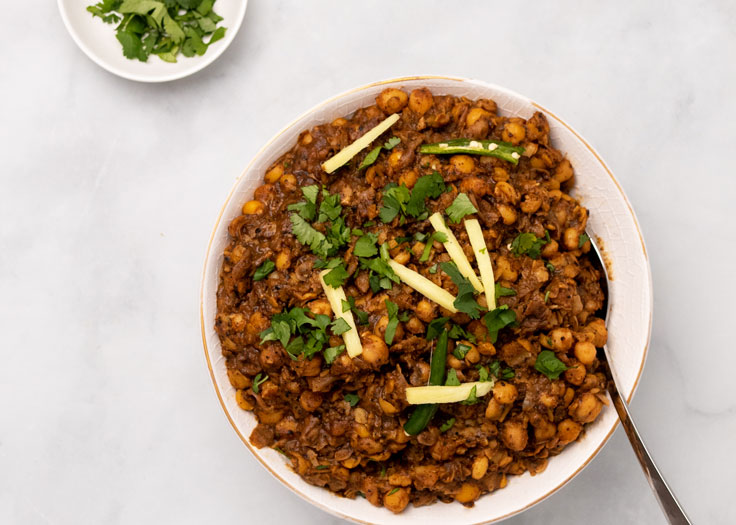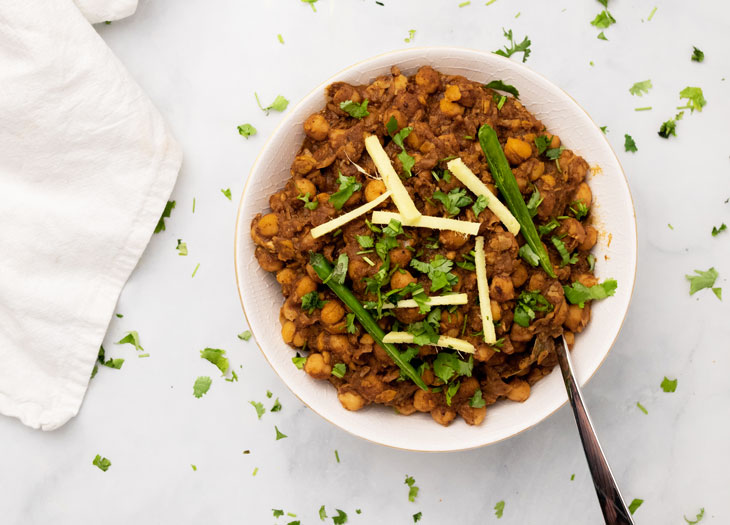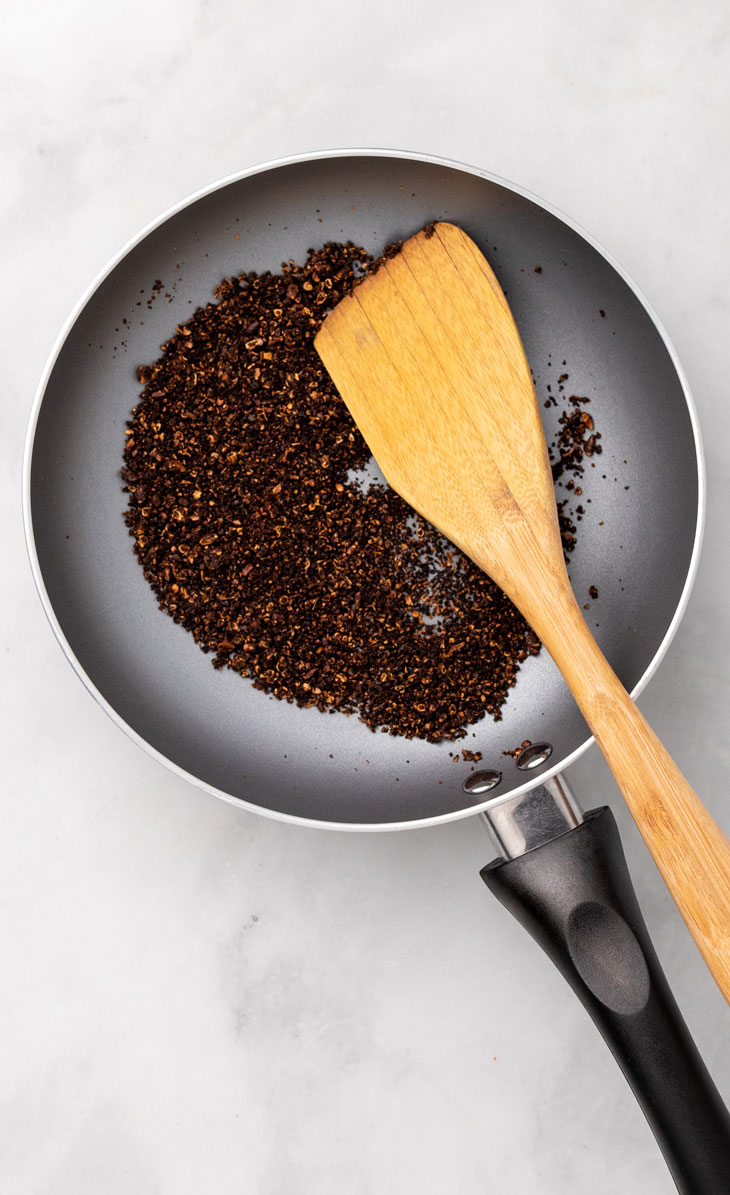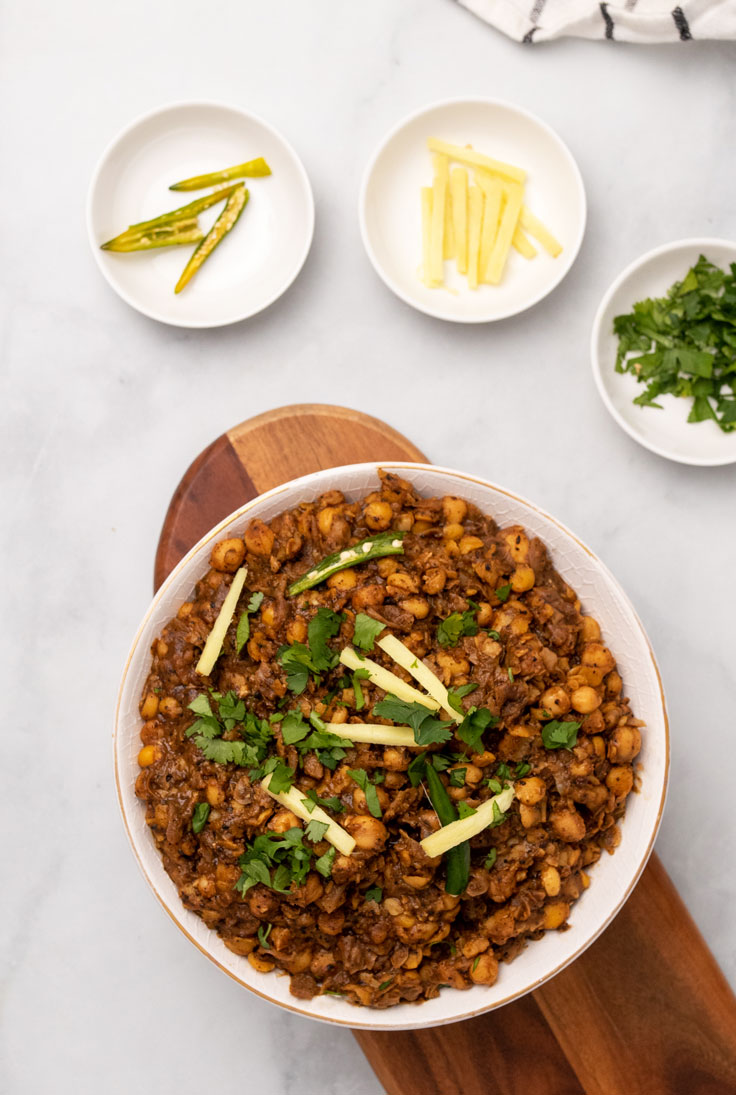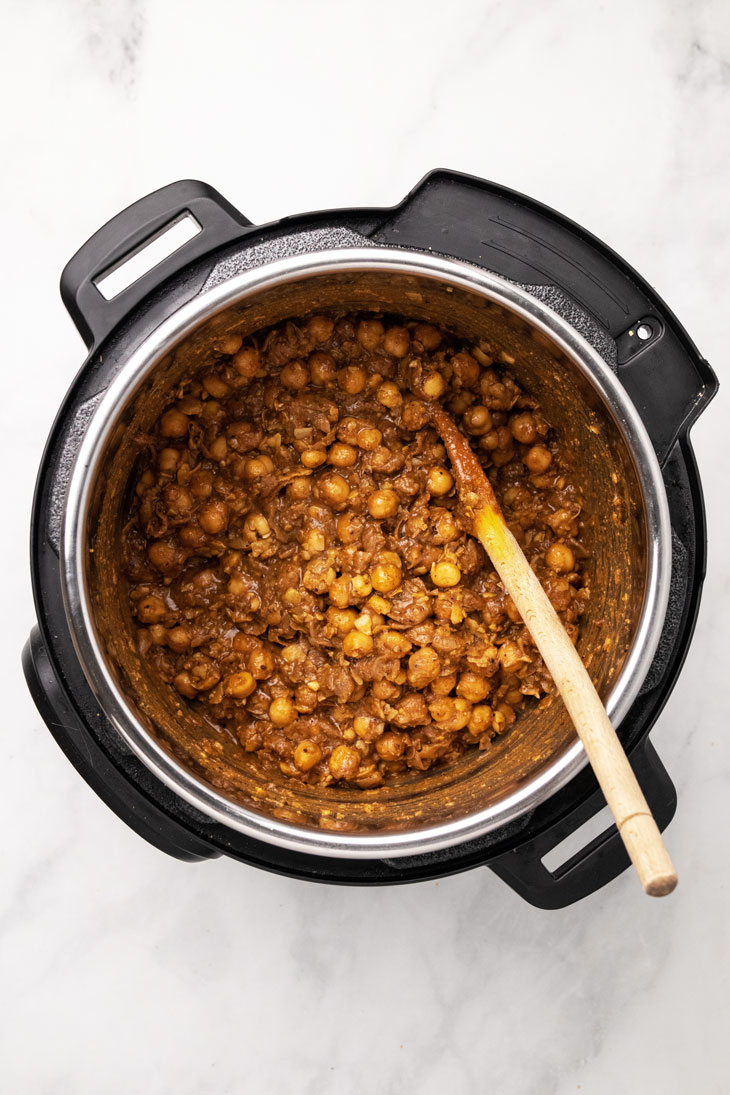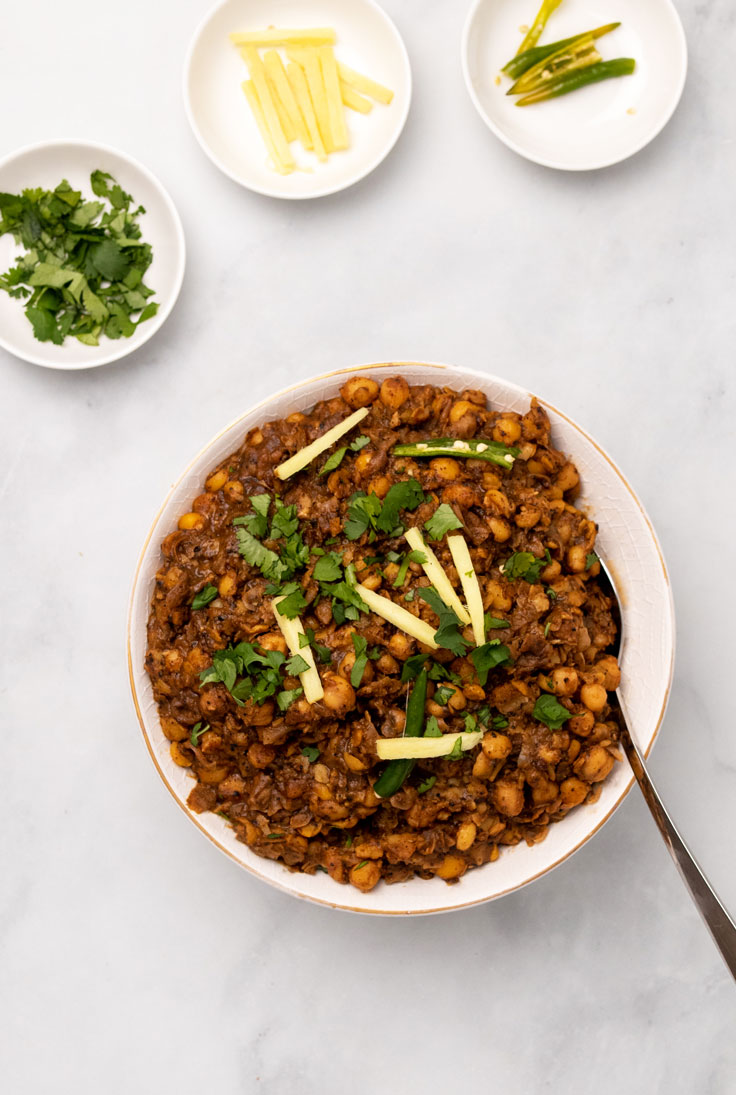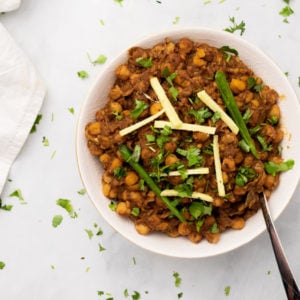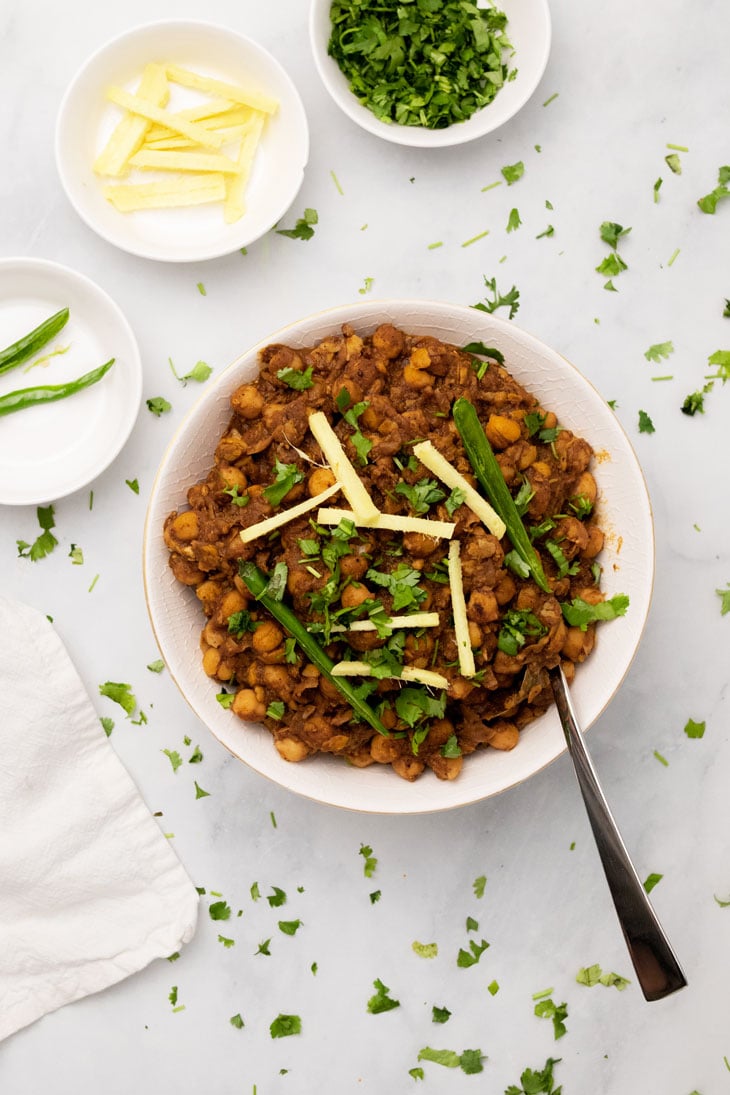I never met my great-grandmother. But I know how she made her cholay. This is my great-grandmother’s recipe for Punjabi chikar cholay, as recited and passed down by memory through at least four generations. My great grandmother taught my Nani (maternal grandmother), and my Nani taught my mom. My mom taught me. I consider this recipe unique because there’s no onion or ginger or garlic or tomatoes IN the recipe (though I do use ginger to garnish). And yet it’s extremely flavorful – in fact, I might go so far to say that it’s one of the most flavorful recipes on my blog.
What is Chikar Cholay?
Chikar cholay (or kichad chole) is a traditional Punjabi recipe (Indian and Pakistani). This dish gets its name from its consistency; chikar translates to mushy or muddy. It has a distinct tangy flavor thanks to the dried green mango powder (amchur powder) and dried pomegranate powder (anardana powder). It also calls for roasted cumin powder and earthy black salt (kala namak). All of the spices in this recipe are important to getting the right flavor. The anardana powder may be new to you. You can buy this powder at your local Indian grocery store or on amazon; it’s just ground-up dried pomegranate seeds. This recipe calls for roasting the powder, which makes it very dark brown, nearly black in color. This spice, along with the roasted cumin powder, gives the chikar cholay its signature dark color and adds an incredible toasted, slightly fruity, tangy flavor. Chikar cholay is different from the more popular Chana Masala in that it is only flavored with spices and oil, whereas chana masala calls for onions, ginger, garlic, and tomatoes. Both recipes call for a different blend of spices. Some thicken this muddy chole with masoor dal (red lentils), chana dal, or with potatoes. My family’s recipe doesn’t call for any of those ingredients. We mash the chickpeas a bit, and it works great. The sauce thickens on its own after a few minutes, once the spices really soak in the oil.
Wait! What’s the white foamy stuff on my chickpeas?
After you pressure cook the chickpeas, you may open the lid to find white frothy stuff on top of the beans. Don’t freak out. If you see foam on your chickpeas, it’s just aquafaba. Many vegan baked goods actually use this stuff because it’s known to be a good substitute for egg whites. You can scoop it out or keep it on – I don’t bother removing it.
Here’s how to make this simple recipe:
The first step is to cook the chickpeas:
While they’re cooking, dry roast the anardana powder on the stovetop and then mix it with the other spices. If you don’t already have roasted cumin powder on hand, now is a good time to make this as well.
Once the chickpeas are done, spread the spices in a layer overtop. Then heat oil and pour it on top of the spices. This cooks the spices and helps bring out their flavor.
Mix it all up, mashing a few chickpeas along the way, and watch as the oil soaks up the sauce and thickens. Amazing!
Some food and family history:
My great-grandmother was born and raised in Sialkot, Punjab, which was part of India until the Partition of 1947, that’s when the British split India (and the state of Punjab) into two: India and Pakistan. That’s why this Punjabi chikar cholay is both an Indian and a Pakistani dish. My great-grandma was apparently a good cook and also a traditional cook. She’d cook family meals over firewood and coal. She’d churn cream into butter (makhan) in a clay pot using a wooden stick (madani), then boil it into ghee. She also heavily relied on home remedies, she’d cook and eat adrak lasan (ginger garlic) sabzi, which she deemed helpful for joint pain, and she taught my mom how to make this lemon pickle to help with digestion (for the record, she was definitely not in the medical field). I sort of feel like she and I are similar in some ways – I also enjoy cooking, and I also often attempt to feed my (skeptical) family members (hi, husband) recipes that I believe will help with their ailments (like turmeric gummies and besan ka sheera). I really wonder what she’d think of me adapting one of her traditional recipes with my instant pot. I want to think she’d think it was cool. I wish I could share a photo of her with you, but I’ve never seen one myself. In fact, even my mom only has one photo from her own childhood in India (which is hard for me to believe as I just upgraded cloud storage because I can’t stop taking photos of my kids… man, times are different). I didn’t know my great-grandma but cooking this dish makes me feel a little more connected to her and my family. Hopefully, when you make this recipe, you’ll feel a bit more connected to me and any others enjoying this same dish. I think that’s one of the greatest things about food – that it connects us all. You can serve this dish with an Indian flatbread (naan, roti, poori, bhatura). This dish has a thick sauce, which is how my family likes it, but feel free to add more water at the end if you prefer a thinner curry. Let me know what you think of this dish! Like this recipe? Pin it to your favorite Pinterest board now so you will remember to make it later!
